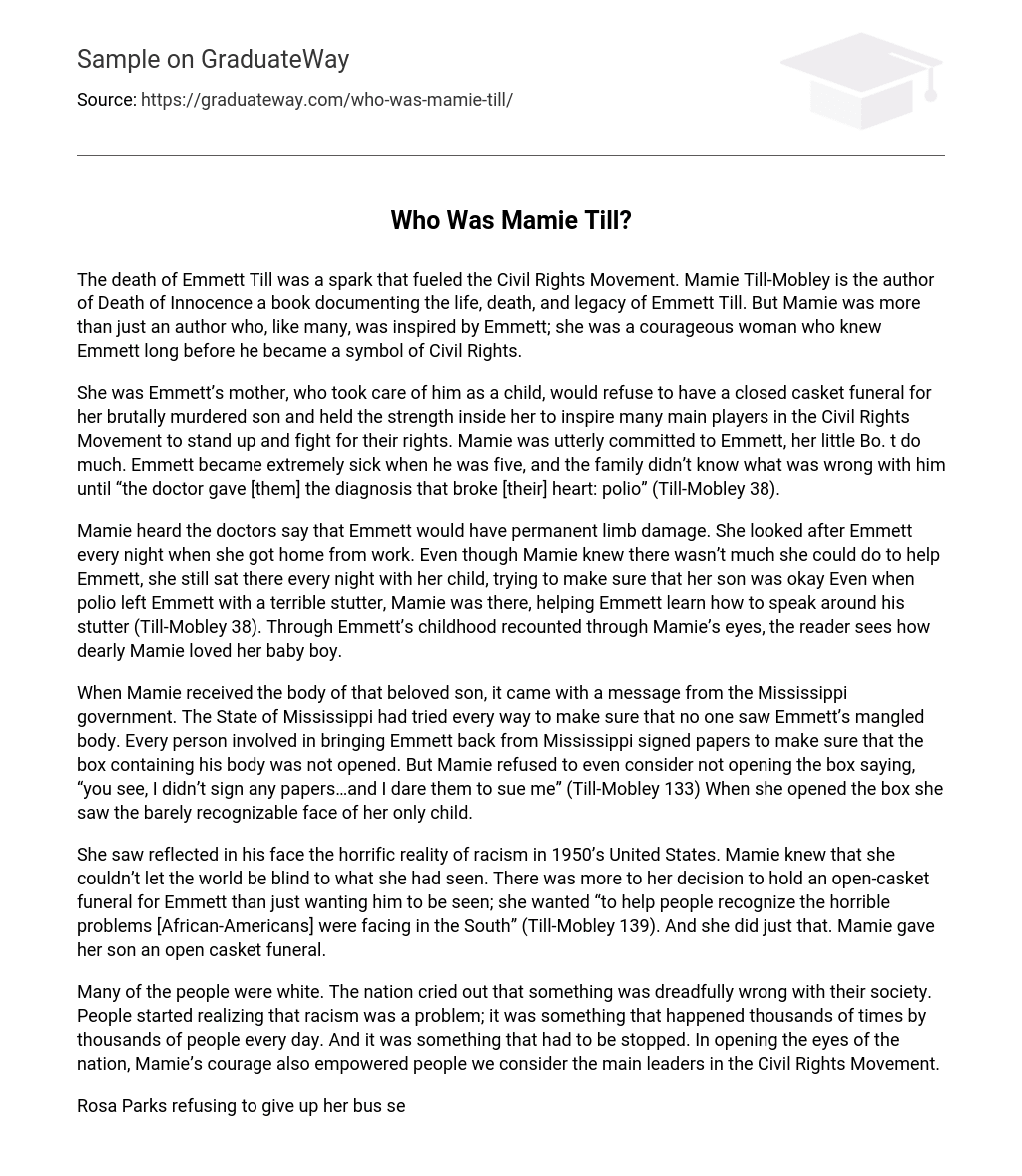The death of Emmett Till was a spark that fueled the Civil Rights Movement. Mamie Till-Mobley is the author of Death of Innocence a book documenting the life, death, and legacy of Emmett Till. But Mamie was more than just an author who, like many, was inspired by Emmett; she was a courageous woman who knew Emmett long before he became a symbol of Civil Rights.
She was Emmett’s mother, who took care of him as a child, would refuse to have a closed casket funeral for her brutally murdered son and held the strength inside her to inspire many main players in the Civil Rights Movement to stand up and fight for their rights. Mamie was utterly committed to Emmett, her little Bo. t do much. Emmett became extremely sick when he was five, and the family didn’t know what was wrong with him until “the doctor gave [them] the diagnosis that broke [their] heart: polio” (Till-Mobley 38).
Mamie heard the doctors say that Emmett would have permanent limb damage. She looked after Emmett every night when she got home from work. Even though Mamie knew there wasn’t much she could do to help Emmett, she still sat there every night with her child, trying to make sure that her son was okay Even when polio left Emmett with a terrible stutter, Mamie was there, helping Emmett learn how to speak around his stutter (Till-Mobley 38). Through Emmett’s childhood recounted through Mamie’s eyes, the reader sees how dearly Mamie loved her baby boy.
When Mamie received the body of that beloved son, it came with a message from the Mississippi government. The State of Mississippi had tried every way to make sure that no one saw Emmett’s mangled body. Every person involved in bringing Emmett back from Mississippi signed papers to make sure that the box containing his body was not opened. But Mamie refused to even consider not opening the box saying, “you see, I didn’t sign any papers…and I dare them to sue me” (Till-Mobley 133) When she opened the box she saw the barely recognizable face of her only child.
She saw reflected in his face the horrific reality of racism in 1950’s United States. Mamie knew that she couldn’t let the world be blind to what she had seen. There was more to her decision to hold an open-casket funeral for Emmett than just wanting him to be seen; she wanted “to help people recognize the horrible problems [African-Americans] were facing in the South” (Till-Mobley 139). And she did just that. Mamie gave her son an open casket funeral.
Many of the people were white. The nation cried out that something was dreadfully wrong with their society. People started realizing that racism was a problem; it was something that happened thousands of times by thousands of people every day. And it was something that had to be stopped. In opening the eyes of the nation, Mamie’s courage also empowered people we consider the main leaders in the Civil Rights Movement.
Rosa Parks refusing to give up her bus seat to a white man is usually considered a starting point of the Civil Rights Movement, but she herself was inspired by Emmett Till. Rosa Parks “had thought about him…when she took that historic stand by keeping her seat” (Till-Mobley 257). Emmett had only been murdered 100 days earlier. Her historic stand caused an outrage, a boycott, and eventually a movement that would forever change the life of African-Americans in the South, and it was all influenced by the murder of a boy who was only 14 years old.
Mamie Till was more than just an onlooker in Emmett Till’s heartbreaking story; she was one of the few people who were influential in his short life. Her love for her son didn’t expire after his death; instead she pushed that love outward. That love for her son was shown to the nation as she refused to let Emmett have a closed casket funeral. Her courage and love in the face of death was inspiring to many who then took it upon themselves to better the African-American way of life.





